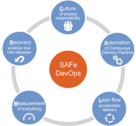How To Scale DevOps Solutions

Source:-hostreview.com
For many organizations, the first step towards their journey for DevOps is quite simple and does not involve much pain. It is just like that some of the new processes take the place of the older ones, and people get trained for such embrace.
However, as per the statement of MD of North Highland, this is just an illusion for the practice. He said that early wins of the organizations could not guarantee the expected result from DevOps scaling. Even there is an important role of DevOps solution providers for this process.
Grinnell, the MD and Global Technology head of North Highland, said, “Often companies run such ‘trailblazer projects and without that to scale such projects, they should leave a trail behind, that others can follow.”
In this technical world, mostly services change often, including DevOps solutions. While it is always exciting to constantly build and push up the new changes, sometimes it also becomes a headache to troubleshoot and coordinate with all the required updates.
How to make the Scaling Process Smoother?
Hyper-growing industries and their engineering teams usually struggle to track all the changes made over the entire group. Sometimes such teams even become frustrated when they find themselves unable to check all the changes made by other team members.
Here we are going to present some advice from experts that can make the DevOps journey smooth even for larger organizations. The suggestions are poured for DevOps scaling even for faster business processes and a speedier development cycle.
First Step towards DevOps Scaling
It is quite clear that when enterprises complete the DevOps efforts for their projects, they start getting requests for the new projects, infrastructure, and applications. With so many hours in a day, this may become difficult to manage the task of all projects with the existing staff. The only option for the organizations is then to expand their capabilities or scaling.
The best practice for such a situation as the first step is to create a process and workflow that can be reused by multiple teams. Apart from this, the teams may also use extra measures to evaluate the performances of the team like cost-saving, time-saving, business results, and others.
The key point here is that whenever there is agility in the business and DevOps is at its beginning, then the organizations can immediately start standardization and normalization their services.
Top-Level Support
DevOps implementation and scaling require heavy backend support by leadership and management that also include C-level executives. The involvement of top management can result in a radical change in software development within organizations.
The same is true for DevOps as well. We have seen top-down adoption of DevOps, and the C-level executives have been the biggest champions of DevOps methodology and technology. The absence of such experts can make DevOps solution implementation difficult.
When all stakeholders work together and share the results, then it becomes easier to implement all the changes. DevOps change or scaling is not radical to those professionals who have been exposed to open-source software, collaboration, transparency, and agile practices.
Role of Metrics and Tools for DevOps Scaling
The teams and organizations that have to embrace various newly launched DevOps tools over the past few years, like Chef, Puppet, Jenkins, and Docker, etc. face various level challenges when they scale the DevOps practices.
Organizations must use metrics to set their agenda. There must be a proof-based model that should include only those DevOps initiatives that have illustrated measurable goals in provable cost and time. The metrics focused on cost-saving and release cycle time may provide competitive advantage and business results.
Some organizations have grown DevOps implementations as a standard set of tools. However, most enterprises use a mix of technologies as DevOps may have various sets of tools, use cases, and infrastructure. Even professionals have to choose the right tool for automation and improved efficiency.
The main frameworks and tools that are an important part of DevOps implementation for any organization are Chef, Puppet, GitHub, Jenkins, Salt, Ansible, etc. These tools are used to simplify automation and tracking infrastructure management, along with software release processes.
Containers are another imperative tool for DevOps professionals that can boost the productivity of the developers, along with their speed. Experts recommend that all organizations must start with a trial of small projects initially.
Conclusion
The important aspect of concern is DevOps failure and acceptance of failure. Any failure in DevOps should be immediately addressed and solved. Organizations should focus on migration and modernization of their existing services and applications. Even the teams and professionals must be ready for any changes.
For scaling of DevOps roles, the organizations must consider these facts. This can make implementation and scale successful. It can be an effective way to adopt the new technology that, too, without alienating existing workers.a